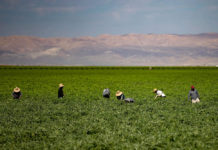Thousands of people visited last weekend’s Steelhead Festival at Warm Springs Dam and Lake Sonoma. The people outnumbered the fish — and that has been our problem in the Russian River watershed for the last 60 years. The epic winter runs of spawning steelhead that once numbered over 50,000 are now down to a very few thousand, if that many.
The mystical and majestic steelhead once worshipped by the native Pomo and made a legend in 1,001 fishermen’s tales is now a “biological marker” for a damaged waterway.
It’s great to have an educational celebration for our endangered salmonids every year because we need all the reminders we can get about the watershed and habitat restoration still needed. Declaring we are fish-friendly is just a beginning. Pledging to be sustainable farmers and conservation-minded municipal water customers all sounds good. But the fish remain extremely outnumbered.
It is valuable to learn about the legacy of our Russian River. It’s important to see how our growing population and changing land uses have changed this history. And, most important of all, we need to continue to write a better future for our Russian River watershed.
The same day as this year’s Steelhead Festival the Russian River and all its tributaries ran full and brown. Lots of rainy runoff was from asphalt parking lots, crowded rooftops and cultivated vineyards. Like us, fish need the rain. But they do better with less soil erosion and urban spillover.
We began damming the headwaters of the Russian River over a century ago. We diverted and altered seasonal flows that disrupted the steelhead’s spawning cycle and home. We channeled the river for flood protection and dug out gravel beds too deeply. We farmed too close to the river’s edge and we cut too many trees from critical upstream habitats. Then, we started sucking too much water from the river for thirsty cities as far away as Marin County.
Now we have learned how wrong we were and how terribly we managed this life-giving natural resource. Now we are sharing those lessons and now we are paying mightily for our past transgressions. But the fish keep paying the most.
We were too late in learning many of these lessons about how we have almost killed off all the steelhead. It took federal actions and new regulations to force us to change our habits and land management practices. We have lots more to learn and much more to do if we truly aspire to be 100-percent sustainable in our land use practices and natural resource consumption.
We spent millions to build the Warm Springs Don Claussen Hatchery to supplement the wild fish populations. We may be saving the numbers of fish, but studies show we are destroying the original genetics of the Russian River steelhead. Besides the steelhead, we have killed or threatened other species of frogs, turtles, freshwater shrimp and plants.
We are paying $8 million per mile to restore the habitat of Dry Creek below Lake Sonoma. That is because we used this important steelhead spawning stream like an open-air pipeline to get water to the Sonoma County Water Agency pumps at Wohler Bridge. We have been removing dozens of man-made dams on the river’s smaller tributaries. But there are still hundreds of these left in place, blocking the fish from their original spawning grounds.
Our recreational businesses have new costs because of federally-required streamflows and seasonal restrictions. Fishing seasons have been curtailed due to drought and might be changed again.
Why should we care about these speckled and finned creatures? So we can continue to “catch and release” them for sport? To continue to have a fun mid-winter festival using their name? Just because some federal bureaucrats call them “endangered” or threatened? Or, because we know we’ve made a better place when the fish again outnumber the people?
— Rollie Atkinson
62.5
F
Healdsburg
April 19, 2025







